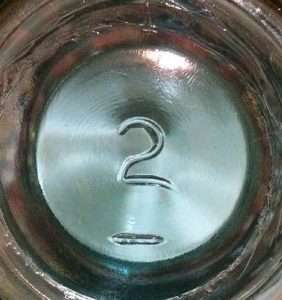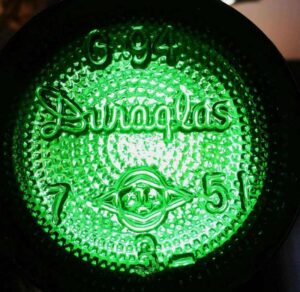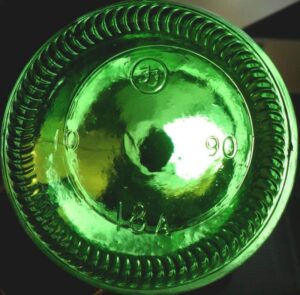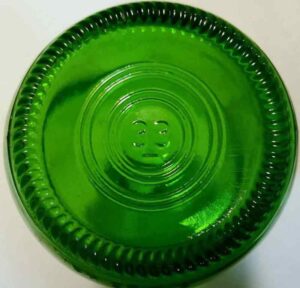NUMBERS ON THE BOTTOMS OF GLASS BOTTLES. I frequently receive inquiries about the interpretation of various numbers seen on the bases of glass bottles. Collectors and others are interested in understanding what the number markings on the bottoms of glass containers mean. Unfortunately, there is no “one answer fits all” to this question!!
(NOTE: the article on this page is pertaining to GLASS containers, and does not apply to the subject of modern / recent PLASTIC containers, which is an entirely separate field of study, and is discussed on many other websites. The number (within a triangle with rounded corners) found on the bottom of plastic bottles is a code indicating the type of plastic the bottle is made from, and pertains to the subject of recycling) .
Always look very closely over the entire glass bottle or other container to see if there is a logo (emblem, trademark, initials, or just a letter) visible that might be a mark that identifies the actual glass manufacturer. Often, a trademark or other marking is embossed on the very bottom of the bottle, or along the lower “heel” of the bottle.
On many bottles, there is no such mark, with only a number or numbers to be seen. In these cases, the general style, shape, glass color and other characteristics may help narrow down the possible age range of a particular specimen.
A large percentage of bottles are marked with only a number, or numbers, on the base (or the heel), and the truth is that, in many cases, it is very difficult, if not impossible to assign a specific glass manufacturer to a bottle if there is no other information embossed in the glass.
Most commonly, single or double-digit numbers embossed on the bottom of a glass item are mold numbers – those numbers served to identify a particular mold (or mold section/mold cavity in use on an automatic bottle-manufacturing machine).
If several identical glass molds were being used simultaneously, each mold would have been assigned a number (a number between 1 and 10, or 1 and 12, etc). If problems occurred with the finished product, it could be easily ascertained which mold is at fault.
Many, many types of commonly-seen glass products have been marked with these types of mold numbers on the base, including bottles, fruit jars, jugs, flasks, candle holders, candlesticks, ashtrays, canisters, dishes, mugs, sugar bowls, salt and pepper shakers, sugar shakers, syrup pitchers, tumblers, tea glasses, punch cups, etc.
ADVERTISEMENT
Numbers also serve other purposes, depending on the exact item or container and/or company being discussed. Some numbers are “year/date of manufacture” codes. Some numbers (for instance, 3- or 4-digit numbers on the base of many British bottles) are catalog, inventory, style or design numbers assigned to a particular bottle shape. (Hazel Atlas Glass Company, Anchor Hocking Glass Corporation, Knox Glass Bottle Company and other bottle manufacturers made a wide variety of glass containers with those types of numbers on the base, sometimes a letter/number combination.)
Those numbers would serve to identify a particular bottle style in communications/orders between the glass manufacturer and their customers ……. that is, the companies that ordered the bottles to package its products. Some numbers were factory location codes. (See my page on Owens-Illinois Glass Company, that used, and uses, location codes on many of their bottles).

Many Ball fruit jars (and other brands) carry mold numbers on the base, such as the underlined “2” illustrated here. They identified the particular mold (or “mold cavity” on the jar-making machine). For more information, see my web page on the Ball Perfect Mason jars.
Many Owens-Illinois Glass Company soda bottles, for a period of time, used “G-numbers” on the bottom (numerals before or after a G), which were codes for a specific bottle shape (design), irrespective of the soda brand name or glass color of the bottle.
Large numbers of American-made whiskey and other spirits bottles (dating between 1935 and the 1970s or later) carry a “Liquor Bottle Permit Number” on the base along with a glass manufacturer trademark and a date code. For more information please check out my page here with a list of those liquor bottle permit numbers: Glass Industry Liquor Bottle Permit Numbers .
Here’s my page about the “FEDERAL LAW FORBIDS SALE OR REUSE OF THIS BOTTLE” marking seen on liquor bottles.
Many liquor bottles are seen with “D-numbers” on the bottom which are distillery identification codes. Someone has put together a list of various distiller code numbers and R-numbers (Rectifier numbers) seen on a wide variety of liquor bottles, with some info on attribution. Here is a link to that page, which is a PDF file: https://static1.squarespace.com/static/51379b83e4b02119d184b2a2/t/584a336ee4fcb59adb85c48b/1481257838281/User+Permit+numbers.pdf
Date codes are often seen, especially on soda bottles from the 1930s to date, and many of these codes are embossed on the base of the bottle, placed to the right of the glassmaker’s logo. This is true on the products of some manufacturers, but not all.
Most modern glass bottles carry date codes, which are often on the heel of the bottle. These date codes are not always obvious, or easy to distinguish from mold numbers. It also depends on exactly which glass company produced the container, as all firms did not / do not use the same system of markings.
ADVERTISEMENT
DOTS or BUMPS around the lower heel of bottles.
In many cases (especially within the last several decades), mold data information is now preserved through the use of small embossed “dots”, “bumps” or raised periods arranged horizontally around the lower heel of the container. More information on this invention (which is rather involved!) and how it works can be found by doing an internet search (Google, Bing, Yahoo or other search engine), using the keyword search terms “EP 0256804 B1 ” , “code reader”, and “Emhart”.
Here are a few photos showing typical bottle bases with numbers on the bottoms. There are numerous ways in which the base of a bottle may be marked, but here are some of the more commonly seen “layouts” of the modern era. You can also see several relatively modern bottle bases on my pages about Owens-Illinois Glass Company and Brockway Glass Company.




NOTE: Please click here to go to the alphabetical list of Glass Bottle Marks , this link points to “page one”. If there is an identifiable mark on the bottom of a bottle, the mark might be listed there. These pages list many commonly seen glass makers’ marks such as “B inside a circle”, “Diamond and oval with an I”, “I inside a diamond”, “O in a square”, as well as initials such as “S B & G CO”, “R & CO”, “A B CO”, “F C G CO”, “I. G. CO.” and many others.
Please click here to go to my website HOME (Welcome) page.
ADVERTISEMENT

